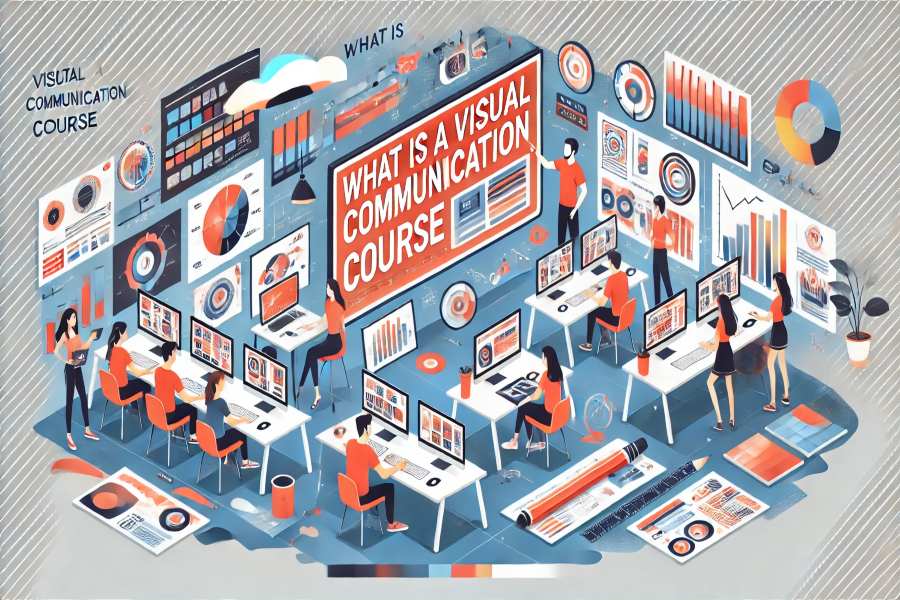The world today is made by visuals. The process of effective communication goes beyond just words. Visual communication forms an intrinsic part of modern media and design fields. A course in Visual Communications enables students with competencies to make persuasive visual content for industries like advertising, journalism, web design, and corporate video production. It puts across knowledge in understanding how to communicate ideas through visualization by studying design principles, typography, digital media, and others. This will expound on what a course in visual communication is all about and its importance, as well as detail the diverse career opportunities that can result from it.
What Is A Visual Communication Course?
In a visual communication class, you will learn how to express ideas or information. You can study graphic design, typography, digital imaging, and multimedia production. The course is intended to empower you with the strength to create visually appealing content across various industries, from advertisement and journalism to web design. You will be empowered to apply the basic elements of design and the principles of visual storytelling in expressing messages effectively to an audience.
Comprehending Visual Communication
It involves visual elements for the conveyance of information and ideas. This ranges from images, graphics, videos, and even animations. It simply means the conveyance of messages clearly and effectively using visual means. In that respect, visual communication forms a substantial part of various fields of interest, including advertisement, marketing, education, and even entertainment. It depends on rudimentary principles of design and aesthetics in creating captivating visuals, which will not only attract the targeted audience but also mean intended messages.
The present world needs visual communication. In the digital age, where social media and other digital platforms have arrived, plain textual content goes nowhere as compared to visual content, which goes viral. It gives brands and organizations a kick to stand apart in the competition. It creates an increment in learning and retention since visual means can convey complex information by simplifying it. Moreover, it crosses language barriers, making visual communication a very potent tool for communication across boundaries.
A course on visual communication would typically entail such key elements as graphic design, typography, color theory, and digital media. Graphic design pertains to the process of visual communication using creating visual elements for several varied media. Typography is the art or process of setting type to make language readable and pleasing to the eye. Color theory focuses on the issue of how to use color in design and the related psychological effects on the reader. Digital media entails all of the different digital technologies used as a medium for the production and distribution of visual materials, whether through the use of photography, videography, or even animation.
Equipped with the course, students learn and acquire several valuable skills; among others are creative thinking, technical skills concerning design software, an understanding of the very basics of design, and, lastly, the art of visual representation. What is additionally brought to students’ knowledge is how to work together on a project with colleagues and integrate new technologies. Such industries as advertising and marketing, web design, and multimedia production highly pursue these.
Elements Of A Visual Communication Course
1. Graphic Design
Graphic Design is one of the core modules of Visual Communication. It deals with the representation of visual content on print, digital, and social media. The students will learn design software—Adobe Photoshop and Illustrator—to create logos, brochures, posters, and other visual material. Apart from learning design concepts, they will be taught design principles that revolve around balance, contrast, and aligning text to bring about that “attractive” feeling to their designs.
2. Typography
Typography symbolizes the art and technique that sets up type to have written language readable and pleasing to one’s eyes. Students taking visual communication classes learn different typefaces, font families, and typographic hierarchies. They also study how different typography pathology affects readability and user experience. One must know and understand typography to come up with effective visual content either on paper or in digital use.
3. Color Theory
Color theory is what is learned to apply color to design, and examines the psychological effect it will have on a viewer. In the module, students are taught color schemes, color harmony, and the cultural meaning of colors. Moreover, it deals with studying how color can be used to express emotions and add visual interest to an image. This element of color theory will become a very important part of a visually appealing design, making an emotional connection with the target audience.
4. Digital Media
Digital media refers to a broad variety of digital technologies used to produce and distribute visual communication content. In the course, one learns digital photography, videography, and animation. They further learn to use social media and other digital platforms to share visual content. Digital media skills are primary in making relevant and engaging content in the current world.
5. Visual Storytelling
Visual Storytelling—Conveying a story through visual means. In a Visual Communication course, one will learn how to apply images, graphics, and videos in telling a story. Students research the elements that compose a story, such as composition, lighting, and pacing. Visual storytelling is important for engaging audiences and communicating messages effectively.
Applications Of Visual Communication
- In Advertising: Visual communication plays an important role in advertising. This is used to create attractive advertisements that are sure to garner audiences. The message is conveyed through the use of images, graphics, and even videos. It creates proper communication and helps the brand to be recognized and remembered by customers.
- In Education: It breaks down complex information into simple, easy-to-understand material. Visual communication facilitates understanding and memory retention. It helps in preparing interesting and interactive learning modules. Diagrams, charts, and videos are used for explaining any concept.
- In Marketing: It is necessary for making amazing marketing material. It delivers the house message of a brand more effectively. These practices include the use of info-graphics, videos, and social media posts in an across-the-board marketing campaign. Good visual communication will improve customer engagement and conversion.
- In Web Design: Visual communication plays a crucial role in making attractive colour schemes on websites. It directly enhances user experience by making it easy to go through the content on the website. The alluring content is created using different visual elements such as images, graphics, and videos. Effective visual communication raises website navigation by improving the usability of the organized information.
The Evolution Of Visual Communication
Historical Perspective
Visual communication dates back hundreds of thousands of years ago, from the people depicted in cave paintings and symbolizations that were realized for informative exchange and telling stories. Slowly, along with changing times, visual communication kept evolving by inventing writing systems, printing technology, and photography. Digital technology introduced in the 20th century completely changed the face of visual communication and opened up numerous avenues for it.
Impact of Digital Technology
The digital age has indeed transformed visual communication. At almost every step, digital tools and platforms make the process of generating and sharing visual content easier. Social media and digital marketing increase the demand for visually appealing content. Digital technology democratized visual communication and empowered people and small businesses to create professional-looking visuals.
Future Trends in Visual Communication
Upcoming technologies like virtual reality, augmented reality, and artificial intelligence will control the future of visual communication. This will hence make visual experiences more immersive and interactive. This fast-track developmental course of technology should increase the importance of visual communication, becoming an evident critical competency shortly.
Conclusion
Visual communication is one of the fundamental skills in the visually-driven world today. A visual communication course assists a student in developing the necessary skills and knowledge to come up with compelling content visually across industries, ranging from advertising and brand marketing to web design and multimedia production—the options are endless. With technology at high speed in development, the role that visual communication serves is only going to get bigger, hence a skill imperative for the future.
Frequently Asked Questions
1. What Is Taught In A Visual Communication Course?
A visual communication course includes graphic design, typography, color theory, digital media, and the elements of visual storytelling.
2. What Would Some Of The Skills Learned In A Visual Communication Course Include?
You can gain skills in creative problem-solving, design software skills, visual storytelling, and understanding design principles.
3. With Any Degree In Visual Communications, What Are Your Career Options?
Career options include graphic designer, web designer, multimedia artist, marketing specialist, and others of that ilk.
4. How Does Visual Communication Come Into The Picture In Marketing?
Visual communication, therefore, happens to be a very crucial part of marketing. It assists in developing exciting content that calls for the eye of the target audience and is bound to convey the brand message properly.
5. What Are Some Future Trends In Visual Communication?
Next-generation trends will include highly immersive and interactive experiences through virtual reality, augmented reality, and artificial intelligence.












































Leave a Reply